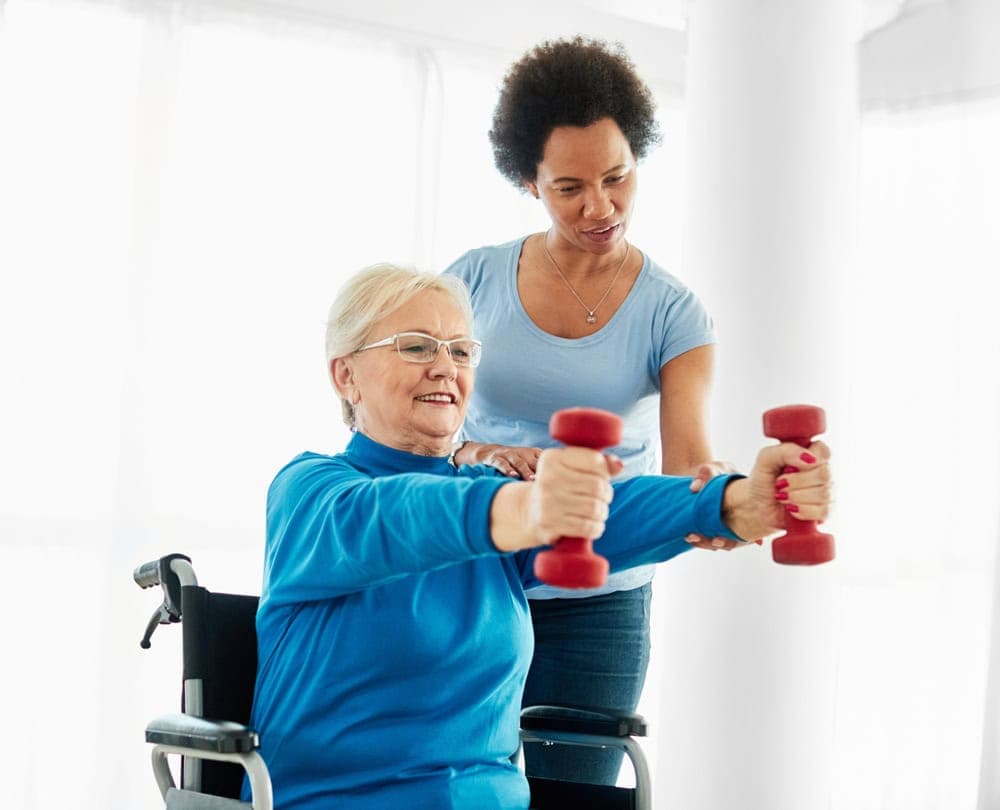Are you considering physical therapy as a career option? Sometimes, you may or may not know what to expect once you become a certified physical therapist. Sure, you might have met a physical therapist or have read several articles on physical therapy(PT).
This exposure will only shed light on a glimpse of what to expect once you join a certified personal trainer program or become a certified physical therapist. Whatever has piqued your interest in PT may be mostly true! But most of what you find, especially online, may paint a picture of a happy physiotherapist smiling as they absently massage or stretch a patient’s leg.
However, the reality of PT as a profession is much more than stretching legs and massaging a patient’s body. Physiotherapy plays a crucial role in improving a patient’s body functions and general well-being, especially when they have mobility issues.
As a physical therapist, you will work in adult day cares, assisted living homes, nursing homes, schools, gyms, and even hospitals. You will mostly treat a wide range of conditions, from sprains to acute cardiovascular issues.

Importance of Physical Therapists In Senior Care
Once you get certified as a physical therapist, you will help patients on their recovery journey after surgery, injury, or a debilitating medical condition. You will help patients regain their mobility, reduce their reliance on pain medications, and improve the quality of their lives.
For instance, you can help a patient manage their lower back pain, play a critical role in treating musculoskeletal health conditions, and educate patients on the importance of exercise and how to stay fit and lead a healthy lifestyle.
As a physical therapist, you will play a crucial role in senior care as you will:
- Recognize any risk factors for chronic health conditions and their potential impact.
- Develop a course of action that will help improve a senior’s quality of life.
- Interpret and predict a senior’s health outcome.
- Collaborate and communicate with other relevant healthcare professionals to help seniors receive appropriate care.
- Promote a senior’s physical health by incorporating scientific principles of function, movement, and exercise.
- Advocate for senior physical education through all levels of education.
- Interpret and integrate the elements of biopsychosocial, health promotion, and medical models that will allow you to monitor a senior’s health status in real-time.
- Apply the best available evidence in prescribing, and selecting intervention strategies to create an exercise care plan for seniors. A care plan will help seniors prevent primary and secondary conditions and optimize their functional mobility.

Different Types of Physical Therapists
While it might be difficult to provide an exact number of potentially available types of physical therapy, this field is continually evolving. New specialties and approaches are emerging over time. As a certified fitness pro, you can develop your unique technique based on your experience and expertise.
Some of the most popular types of PT are:
- Neurological PT
- Geriatric PT
- Orthopedic PT
- Pediatric PT
- Electrophysiologic clinical specialist
- Cardiovascular PT
- Women Health PT
- Pulmonary PT
- Oncology specialist
- Sports PT.
- Balance and vestibular therapy
Let’s go over some of them.
Geriatric Physical Therapists
A geriatric physical therapist is a PT who specifically deals with seniors and addresses their unique challenges and issues.
As a geriatric physical therapist, you need to understand that most seniors tend to become less active as they age, will experience a decrease in their coordination, muscle strength, and balance, and have poor reaction timing, as well as lower tolerance to physical activities.
Due to these factors, you will have to concentrate on strength and endurance building while helping a senior with PT.
Strength and endurance building will help an older adult:
- Keep active
- Help them prevent the risk of falls and re-injuries
- Help in preventing deconditioning
- Retain their independence
As a geriatric PT, you will work in the following settings:
- Inpatient facilities (nursing homes, hospitals, rehabilitation centers, and assisted living homes)
- Outpatients clinics
- A patient’s home.

Orthopedic Physical Therapists
An orthopedic PT focuses on the treatment of musculoskeletal injuries and conditions (sprains, joint replacements, and fractures). As an orthopedic PT, you will need additional training in orthopedics.
Orthopedics is a field of medicine that deals with treating injuries to tendons, ligaments, bones, and muscles (the musculoskeletal system).
As an orthopedic PT, you will help your patients to function better and reduce pain. You will also help patients recover after surgery and regain the functionality of the operated body part. You can apply the following methods while treating patients:
- Massage
- Strength training
- Muscle stimulation
- Education
- Exercise
- Ice and heat application
- Joint mobilization
You will mostly work in hospitals, and outpatient clinics, or visit patients at their homes.
What Do You Require To Become an Orthopedic PT?
To qualify as an orthopedic PT, you must:
- Earn a doctorate degree in physical therapy from an accredited institution
- Pass the exam to practice PT in a specific state
- Attend an Orthopedic specialist certification program or complete clinical residency.

Neurological Physical Therapists
As a neurological physical therapist, you will specialize in evaluating, treating, and helping patients with injuries, illnesses, or movement issues related to the nervous system. Your role will be to help patients regain their mobility functions, enabling them to retain their independence and dignity.
A neurological physical therapist works with patients with the following medical conditions:
- Multiple sclerosis,
- Spinal cord injuries,
- Strokes,
- Parkinson’s disease,
- Brain injury,
- Ataxia,
- Progressive neurological conditions,
- Guillain-Barre Syndrome,
- Spasticity,
- Amyotrophic lateral sclerosis.
The Impact of Neurological Physical Therapy on a Patient’s Life
Neurological PT is extremely crucial in a patient’s life who has had a neurological disorder. You realize that the brain, spinal cord, and the central nervous system(CNS) control a person’s sensations and movements.
With a neurological disorder, a patient may lose their mobility, and sensory functions. When a patient seeks neurological PT after a neurological injury early, they are in a better position to regain neurological functions and be in a position to perform activities of daily living.
Following a neurological injury, brain and spinal cord cells that are not injured may sometimes learn to control the functions of the injured cells for some time. This may result in a different walking style or jerky movements.
As a neurological PT, you will help your patients relearn how to use their recovered cells. This is crucial as it helps in correcting movement patterns that may have been altered by the CNS to cover for the injured cells.
As a neurological physical therapist, you will help your patients to:
- Improve functional strength and movement
- Restore their range of motions
- Improve safety of mobility and transfers
- Avoid falls
- Improve motor control and planning
- Posture realignment
- Core stabilization
- Cardiovascular endurance
- Orthoses training
- Equipment evaluation and recommendation
- Gait training
- Decrease spasticity.

Overview Of The Various Physical Therapy Settings For Seniors
If you are passionate about senior care, you may wonder how you will achieve your dream of working closely with the elderly once you become a personal trainer. This shouldn’t be the case, as you can interact with and help seniors in different settings.
Some of these settings include:
Acute Care Hospital and Rehabilitation Centers
At an acute care and rehabilitation center, you will get the opportunity to help patients recovering from surgeries and injuries heal. Suppose you have just sat for your personal trainer certification exam. In that case, you can volunteer at one of these facilities, as the fast pace and patient interaction will help you gain firsthand knowledge of what to expect once you graduate.
An acute care facility will allow you to work on different types of injuries and illnesses, thus expanding your knowledge and experience. You will work on patients who have been involved in traumatic accidents, leaving them with loss of limbs, to others with debilitating cases of pneumonia, which leaves them weak and requiring assistance even to leave bed.
Skilled Nursing Facility(SNF)
A skilled nursing facility offers long-term care with round-the-clock skilled rehabilitative services and nursing care. SNFs offer physiotherapists, speech-language, and occupational therapists a satisfying and challenging working experience, resulting in the most in-demand and highly-paying jobs.
Working with seniors in SNF will be a great career move for you, as you will start earning as soon as you get certification in the industry.
Since skilled nursing facilities house patients who require help performing activities of daily living (ADLs), you will be in a position to assess and determine whether their functional mobility is declining or improving. You can then develop a care plan that addresses each patient, which will go a long way in promoting their recovery and healing.
Private Practice
If you choose private practice, you will be working with seniors in an intimate setting, which is rather smaller. You can work with several patients or only one, depending on your specialty. As a private practice PT, you will mostly specialize in providing in-depth services to your patients.

Wellness Center
A wellness center focuses on the application of preventive therapy and improving the physical condition of their patients. You can choose to work in a wellness center if you don’t like dealing with patients who have severe injuries and medical conditions.
You will be a part of a large community that dedicates its time and expertise to helping seniors improve their balance and exercises avoid re-injuries and lower the risk of falls.
Inpatient Rehabilitation
If you want to practice the purest form of physiotherapy, then inpatient rehabilitation should be the place to work. Here, you will work with patients who need to gain enormous functional ability within a short period. Your patient will spend 3-4 weeks in inpatient rehabilitation, and you will work closely with professionals from various disciplines.
In an inpatient rehabilitation facility, you will deal with patients who have suffered traumatic brain injuries, stroke or were involved in traumatic accidents. These patients need assistance with their ADLs, and sometimes even with their speech.
If you have just graduated, you will have to shadow a certified PT to gain the hands-on knowledge needed in these facilities. But with time you will gain confidence to handle patients on your own!
At Home
There are physical therapists who provide PT care to patients who are having difficulty moving around in the comfort of their homes. Sometimes a doctor may prescribe in-home PT to patients who:
- Have a recent heart attack
- Knee or hip replacement surgery
- Keep falling
- Have balancing troubles
- Acute medical condition
- Difficulty walking around
- Cancer
- Stroke
- Deteriorating medical conditions like diabetes, COPD, or heart failure
- Functional decrease due to progressive medical conditions like multiple sclerosis, ALS, or Parkinson’s disease
- Cerebral Palsy
- Acute brain or spinal cord injury
- Alzheimer’s disease
- Amputation
- Incontinence
- Burns.
As an in-home PT, your role will be to help your patient to move with ease and develop a care plan that accommodates their unique needs.
Outpatient Physical Therapy Clinics
In outpatient physical therapy clinics, patients seek PT services outside their homes. A patient will travel to the clinic for their therapy sessions.
In an outpatient PT clinic, you will most probably see your patients bi-weekly for at least a month. Depending on the extent of their injuries, some patients may require longer rehabilitation time.
Your role as a PT in an outpatient clinic will be to perform exercises that focus on muscle strengthening and stretching a patient’s tight muscles to help improve their balance and posture.
You will use the following techniques while helping your patient at the outpatient clinic:
- Therapeutic exercise for muscle strengthening and stretching
- Balance training (helps in improving dynamic balance)
- Manual therapy (soft tissue mobilizations, stretching,
- Deep tissue massages
- Endurance training (with equipment like treadmills, ellipticals, and bicycles)
- Gait training
- Thermal therapy
At outpatient PT clinics, you will handle some of the following conditions:
- Fractures
- Joint problems
- Muscle strains
- Arthritis
- Spinal stenosis
- Muscle tears
- Nerve compression

Personal Training Certification for Physical Therapists
Continuous learning and obtaining personal training certification as a physical therapist is vital if you want to advance your career. The healthcare field is ever-evolving, and as a PT, you need to stay up to date with the evolving innovations, techniques, and technologies to provide excellent care to your patients.
Importance of Certification for Physical Therapists
As a licensed PT, you need to gain physical therapy certifications to demonstrate your expertise in your chosen practice field. This certification will involve getting additional training that goes beyond the minimum requirements for a PT certificate.
Some of these certifications will require you to pass some exams or accumulate some form of clinical experience. With these certifications, you will have an opportunity for career growth and gain the necessary skill sets, and this will increase your credibility.
Certification for PT will enable you to specialize in a certain field, such as pediatric, geriatric, or sports physical therapy. With extra certification, you will also demonstrate your commitment and competence in your profession and patients.
Additionally, with certification in a specific physical therapy field, you will assure your patients that they are receiving the best care and they are in safe hands.
Certification Programs
Once you have decided to pursue a fitness career, the first step is to research its certification options. You need to understand that being certified is completely different from licensure (a state-governed process that ensures all PTs are competent to practice). You will obtain your certification from professional organizations that prove that you meet specific requirements and qualifications to practice in your field.
To avoid confusion when choosing a certification program, go for one that is accredited by some of the following reputable organizations:
- American Council on Exercise(ACE)
- National Commission for Certifying Agencies(NCCA)
- National Academy of Sports Medicine(NASM)
- American College of Sports Medicine(ACSM)
- International Sports Sciences Association(ISSA)
- National Strength and Conditioning Association (NSCA).
When searching for the certification program, it is crucial to compare some of the following factors:
- Prerequisites
- Cost
- Recertification requirements
- Exam details
- Interests.
Obtaining certification increases your value to potential employers and patients while improving your job satisfaction. Start investing in your future by exploring the best advanced PT certification.
Some of these certifications include:
Advanced Certified Manual Therapist (ACOMT)
The ACOMT certification is a very demanding program that will provide you with advanced knowledge and skills necessary when treating complex musculoskeletal health conditions.
Currently, this is the highest level of manual therapy that you can attain in the United States as a physical therapist. Advanced manual therapy applies techniques that help improve patient outcomes. As an ACOMT, you will apply techniques such as soft tissue mobilization, joint manipulation, myofascial release, and muscle energy to help your patients.
Certified Orthopedic Manual Therapist (COMT)
For this certification, you will receive intense training on manual therapy techniques for musculoskeletal systems, specifically targeting orthopedic conditions.
Vestibular (VT)
This certification will equip you with the necessary skills to diagnose and treat vestibular impairments. Vestibular rehabilitation improves patients’ quality of life. It is an ideal treatment option for patients with dizziness and balance conditions, as it helps reduce limitations while promoting function levels.

Career Opportunities with Certification
With additional certification to your physical therapy degree, you can specialize in a specific type of physical therapy and provide more value for your patients.
If you are passionate about teaching and mentoring, you can pursue a career as a Residency Mentor. In this role, you will be in a position to guide aspiring physiotherapists and help them navigate available residency programs. Additionally, by sharing your expertise and knowledge, you will leave a lasting impact on the PT you are helping.
Take away
When you decide on physical therapy as a career, you need to understand that it plays a crucial role in promoting a better lifestyle and helping to improve a patient’s functionality. There are different types of physical therapists, and you need to identify with one that you know you will excel in.
Another factor to consider is where you would love to work once you graduate. For instance, if you are passionate about seniors, you can specialize in geriatric physical therapy or become a sports physiotherapist if your interest is in sports or athletics.
Patients will seek you once you advance your education as this builds trust, and they will know you have relevant knowledge to help them with their health condition. When a patient schedules an evaluation appointment, they get an incline if you are in a position to help them. If they gain confidence in you, they will continue seeking you and even refer their family and friends, and this will help build your career.
Apart from job satisfaction, you will have job security and a potential increase in your salary. One of the advantages of pursuing PT as a career is the opportunity to make a positive impact on your patients’ lives. At Amy’s Eden, we work with physiotherapists in Nevada to ensure our residents lead comfortable and active lives.
If you are certified and licensed to practice, don’t hesitate to contact us and help us ensure our residents enjoy their golden years independently as much as possible.




